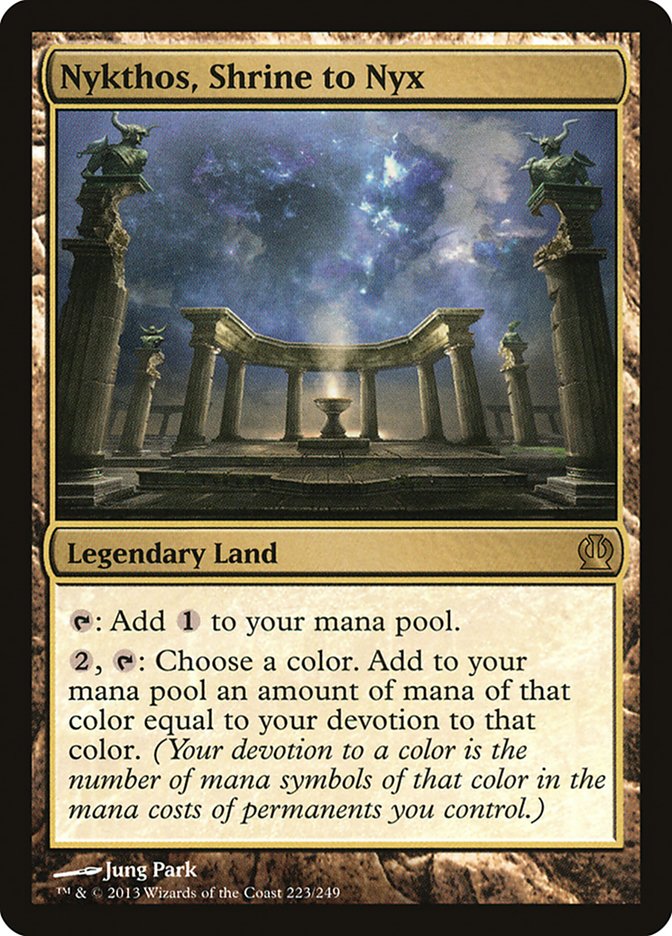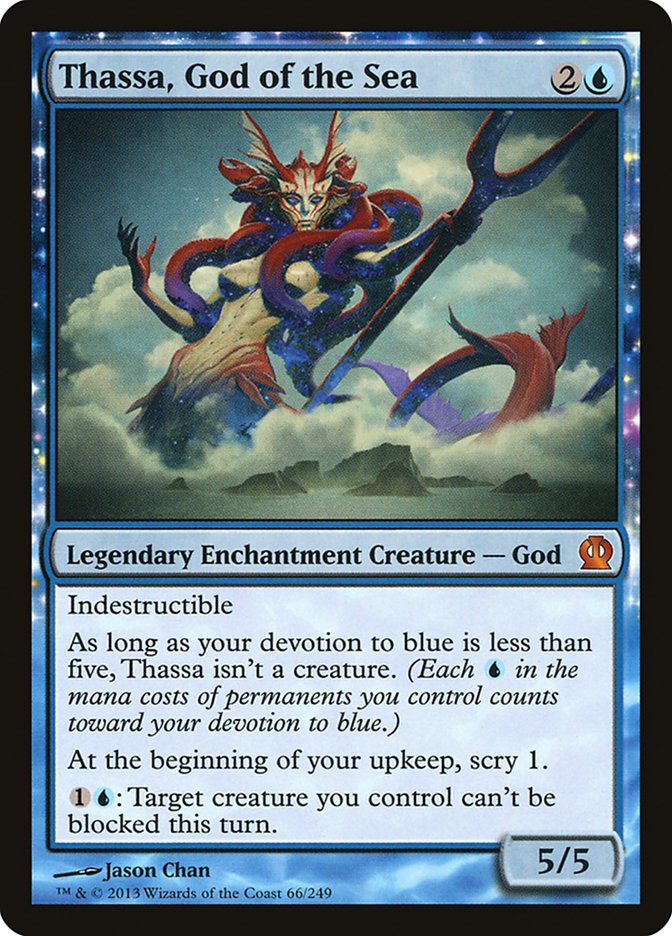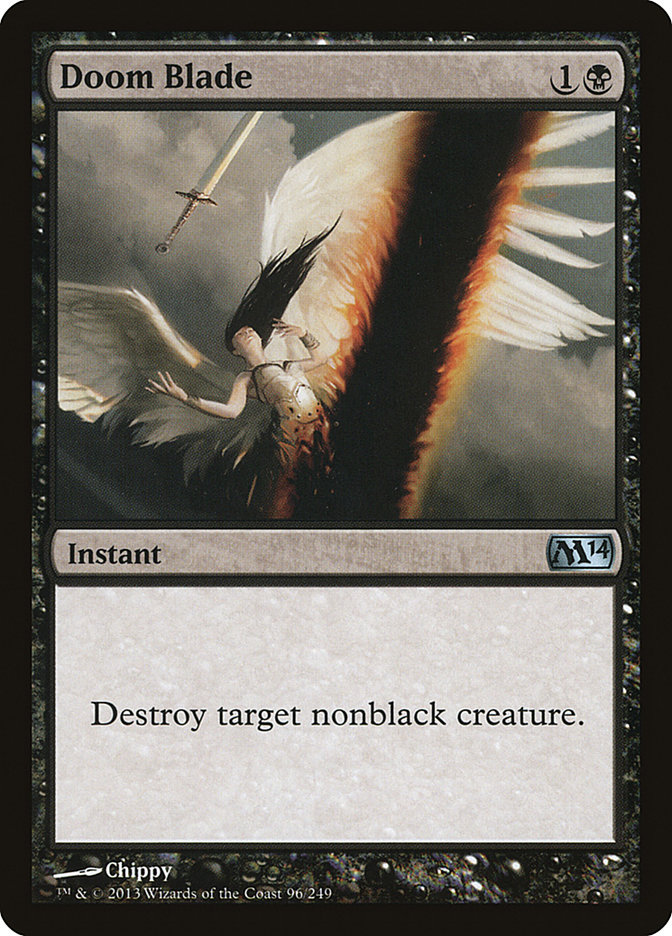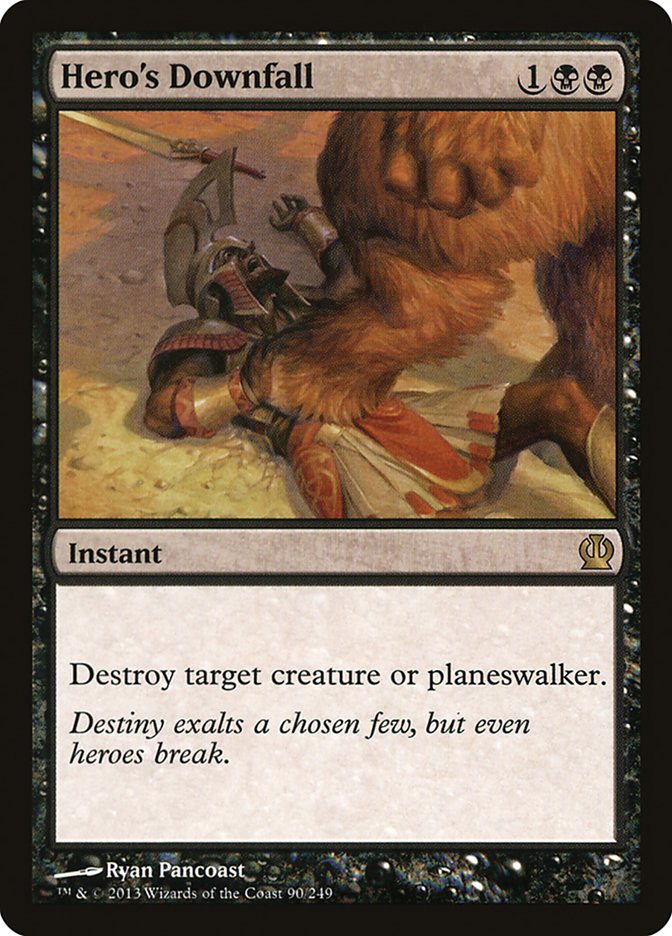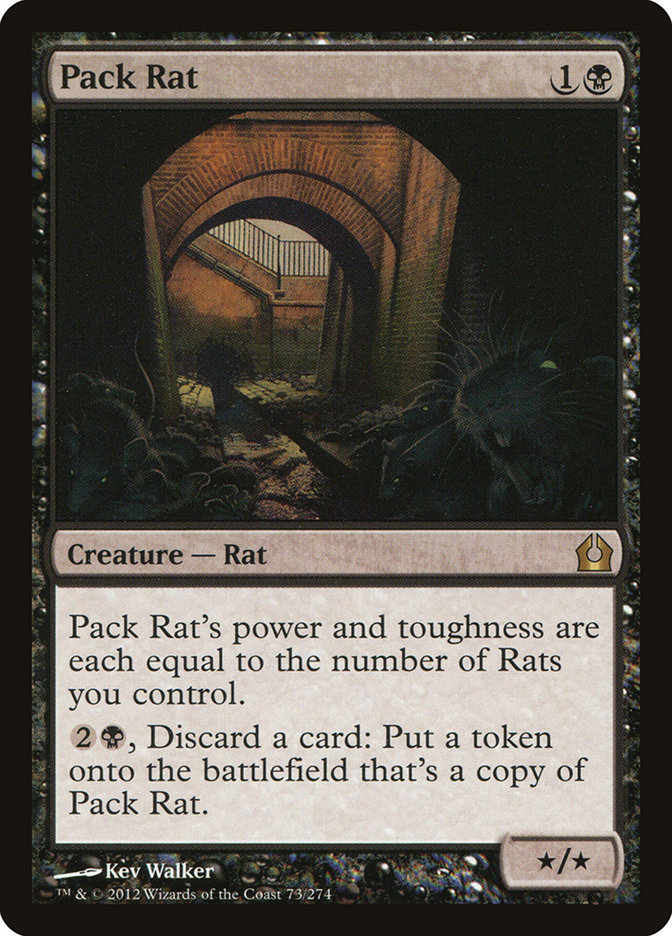The Top 8 of this past weekend’s Pro Tour Theros did not disappoint.
The storylines were wonderful.
A handful of Magic: The Gathering’s true masters showed off their skills, with at least three making strong cases and padding their resumes for potential Hall of Fame runs come next year’s ballot.
Our own home team of Team StarCityGames.com represented wonderfully, putting multiple players into the elimination rounds wielding multiple different decks.
Speaking of different decks, many and most of the performing decks were relatively new looks at Return to Ravnica Block-Theros Standard despite two weeks of SCG Standard Opens.
Of all the things that came together in Dublin, the most unifying overarching theme—from a deck strategy standpoint at least—was the Theros mechanic devotion, in particular its cross-color poster boy legendary land: Nykthos, Shrine to Nyx.
Dublin’s Pro Tour Theros Top 8 featured black, blue, green, and red Devotion / Nykthos, Shrine to Nyx decks!
While that might seem at least initially as a strong blow in favor of diversity, by the same token the breakout strategy of the Pro Tour—both from the perspective of being the primary Team StarCityGames.com deck (placing our own Sam Black in Top 8) and in the hands of Jeremy Dezani the winning deck—was a Mono-Blue Devotion that placed three Magicians into the Sunday brackets.
The Pro Tour Theros Top 8:
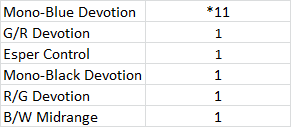
Mono-Blue Devotion
Creatures (30)
- 4 Judge's Familiar
- 4 Frostburn Weird
- 4 Cloudfin Raptor
- 4 Nightveil Specter
- 4 Tidebinder Mage
- 4 Thassa, God of the Sea
- 2 Omenspeaker
- 4 Master of Waves
Planeswalkers (2)
Lands (24)
Spells (4)
Sideboard

Creatures (29)
- 4 Judge's Familiar
- 4 Frostburn Weird
- 4 Cloudfin Raptor
- 4 Nightveil Specter
- 4 Tidebinder Mage
- 4 Thassa, God of the Sea
- 1 Omenspeaker
- 4 Master of Waves
Planeswalkers (1)
Lands (25)
Spells (5)
Sideboard

Creatures (30)
- 4 Judge's Familiar
- 4 Frostburn Weird
- 4 Cloudfin Raptor
- 4 Nightveil Specter
- 4 Tidebinder Mage
- 4 Thassa, God of the Sea
- 2 Omenspeaker
- 4 Master of Waves
Planeswalkers (1)
Lands (24)
Spells (5)

These Mono-Blue Devotion decks are all very similar to one another. They lay out tons of permanents starting on turn 1 to get blue pips in play. In all their cases that helps to get Thassa, God of the Sea online—and in the case of Sam Black version Nykthos, Shrine to Nyx as well.
Dezani and Dagen both played the fourth Mutavault in their sideboards; Team StarCityGames.com maintained that playing four Mutavaults was a super important—even defining—decision for the strategy.
Thassa, God of the Sea is the cheapest of the Theros God cycle, lending itself perhaps a bit surprisingly to an aggro deck despite the grindy scry ability. And make no mistake—Mono-Blue Devotion as it has been envisioned to this point is an aggro deck.
I think that our collective gut reaction is to assume that a blue aggro deck is going to be an Aggro-Control deck or a Fish deck (heck, all these decks have eight Merfolk), but I think that an important clarification is that they’re not—at least not maindeck. Mono-Blue Devotion is, in the parlance of Next Level Deckbuilding a Swarm deck. In many ways Mono-Blue Devotion has more in common with White Weenie than it does with Faeries or Blue Skies.
Mono-Blue Devotion can draw cards like a blue deck; Bident of Thassa kind of turns every creature into an Ophidian. But the important thing to note is that the deck (at least maindeck) pretty much just draws more little guys. This is actually something that has come up for me testing post-Pro Tour. Your opponent attacks you, you can’t stop them [yet], they draw a bunch, they draw a bunch next turn. You really want to concede game and go to boards, only . . . all he’s drawn is more Cloudfin Raptors! If you have a non-interactive, over-the-top, or powerful control strategy, you can easily come back despite the opponent drawing a ton of extra cards.
That is the primary difference in looking at Mono-Blue Devotion as a Swarm deck rather than a Fish or Aggro-Control deck. When playing against some of those decks, the opponent gets the initiative, starts beating on you, draws some extra . . . but draws cards like Cryptic Command, Mana Leak, or Thwart that allows them to keep the initiative through your key response spell.
A topic that I overheard at New York States this year was the card quality in Mono-Blue Devotion. Some players just couldn’t wrap their heads around the idea that Jon Finkel was summoning a Cloudfin Raptor. Isn’t that a terrible topdeck? I guess, sure. But not only is this 1) an aggro deck rather than a control deck, but 2) the intended audience across the table [at the Pro Tour] is in all likelihood a Magician of substantial skill.
You might remember an article a few years ago by Brad Nelson about winning with his Extended Treehouse deck from his Player of the Year run. Brad noted that the most important thing was drawing his one-drop. Putting on pressure early. Sneaking in just one or two points to close what might otherwise have been a tight race. So sure, Cloudfin Raptor can be a weak topdeck during the midgame, but the opportunity to get the jump on the opponent in the Pro Tour makes it an important inclusion even if it seems like one of the weaker cards in the deck.
Now, none of this is to say that Mono-Blue Devotion isn’t dangerous. White Weenie can be a dangerous deck! It is just to note that it might look like something familiar but that it actually acts like something else that is actually also familiar; I think it will be helpful for playing against this breakout deck to beat.
That said, all these decks have access to Dissolve, Gainsay, and / or Negate after sideboarding, so even if they are White Weenie main, they can go Counter-Sliver side (especially against other blue decks).
Mono-Blue Devotion enjoyed some level of being unknown coming into Dublin. While there is an intuitive sameness that pervades many teams’ versions of the deck, we must assume that there was at least a minor amount of surprise value that Mono-Blue Devotion players will no longer enjoy. In Dublin, at least some percentage of players would have played tentatively against a wave of Bident of Thassa card drawing; what has he got coming? Many players would have approached their blue opponents as Aggro-Control rather than Swarm. They would have made one or two strategic missteps . . . too many. The classic "Bob Maher has no Counterspell" advantage that works well on the first day but never after the tournament.
I would guess that Mono-Blue Devotion, while remaining viable especially in the near term, will enjoy quite a bit less success than 3/8 of the average Top 8.
G/R Devotion
Creatures (28)
- 3 Scavenging Ooze
- 4 Burning-Tree Emissary
- 4 Elvish Mystic
- 4 Polukranos, World Eater
- 2 Nylea, God of the Hunt
- 4 Sylvan Caryatid
- 3 Arbor Colossus
- 4 Voyaging Satyr
Planeswalkers (9)
Lands (23)

Former Dragonstorm World Champion Makihito Mihara brought a different set of mana accelerators and big monsters to his most recent Pro Tour Top 8.
While we have seen some green-based and/or G/R Monsters deck already in our explorations of Theros Standard, those decks have been more in the flavor of midrange aggro, whereas Mihara’s is again in the parlance of Next Level Deckbuilding a Big Spell deck.
Like many Big Spell decks, Mihara’s plays two broad buckets of cards: accelerators and bombs.
Accelerators:
- Elvish Mystic – The only one-drop accelerator; useful for playing a second-turn Domri Rade.
- Burning-Tree Emissary – Allows you to get tons of pips into play early; super powerful with Nykthos, Shrine to Nyx (of which this deck plays four). For example, turn 1 Elvish Mystic, turn 2 Burning-Tree Emissary, Burning-Tree Emissary (RG floating), Nykthos, Shrine to Nyx –> Arbor Colossus. On turn 2!
- Sylvan Caryatid – I’ve actually been increasingly impressed with this card. It is an okay blocker that goes the extra mile due to hexproof.
- Voyaging Satyr – Kinda sorta the weirdest and weakest card in the deck. Voyaging Satyr doesn’t have a natural acceleration ability but rather can untap a land to fix you mana and/or give you a second tap of your Nykthos, Shrine to Nyx on a big turn.
The bombs are largely intuitive, but the namesake might not be (or at least might not have been before this Top 8). Arbor Colossus has a lot going for it. It is a 6/6 for five mana, putting it a mite above the curve. It has GGG in the upper-right corner, giving it some extra pips for Nykthos, Shrine to Nyx or Nylea’s Disciple. Perhaps most importantly Arbor Colossus matches up well with some of the defining creatures in the format. Desecration Demon is a house in Standard, and Arbor Colossus can hold ground against it; with just one more mana it can knock Desecration Demon, Stormbreath Dragon, or other key flyers right out of the sky.
Esper Control
Creatures (1)
Planeswalkers (6)
Lands (26)
Spells (27)

On the subject of players making cases for the Hall of Fame, Guillaume Wafo-Tapa return to Top 8 play was accomplished unsurprisingly with a card draw-heavy control deck.
Wafo’s take on Esper Control is a study in certainty. Four Doom Blades. Four Hero’s Downfalls. These are the decisions of a Magician who knows what he wants in life and how he wants to kill creatures. The B/R decks of the positive-record decklists largely played a mix of Hero’s Downfall and Dreadbore; fellow Top 8 competitor (and fellow Pro Tour Champion) Paul Rietzl played only three Doom Blades main. The certainty of Wafo’s decklist is visible by his three colors. Other decks with fewer options shave these creature-removing four-ofs despite having fewer options. Guillaume played Supreme Verdict as well and still figured he wanted the pair of four packs!
Wafo also played a ton of win conditions main and side. Though he only ran the one Aetherling (a resolved Aetherling excelling primarily in killing control opponents), he ran a ton of planeswalkers starting. In his sideboard were tons and tons of threats. Another Aetherling, Blood Baron of Vizkopa (an aces game winner in numerous matchups), and cheaper drops like Soldier of the Pantheon and Sin Collector.
Soldier of the Pantheon has multiple applications. It’s just hell on Naya’s normally high-quality guys like Loxodon Smiter and Boros Reckoner, but it is also a potential turn 1 play against another control player [who might not have an answer in their deck any longer]. Sin Collector and Soldier of the Pantheon both give this control build some earlier-game initiative, allowing Wafo-Tapa to start winning a game well before the opponent might have predicted. And, of course, it is entirely possible with only Azorius Charm available that such an opponent might have no way easy way of matching wits with either 2/1.
Mono-Black Devotion
Creatures (15)
Lands (25)
Spells (20)
Sideboard

To my mind, Yamamoto’s deck had the most eyebrow-raising head scratchers in the Dublin Top 8. Yes, that is Temple of Silence in a one-color deck. And yes, Pack Rat finally makes an appearance in Constructed deck! The bet is that Temple of Silence costs this deck less than it provides. One set of lands that come into play tapped doesn’t cost too much, especially with sixteen Swamps and more than twenty lands that hit play untapped and pain free basically all the time. And as to Pack Rat? There is some method to Yamamoto’s madness.
The really defining piece of technology here is in those four copies of Underworld Connections. This deck is in many ways an inheritor to Necropotence. Yes, it is 2013, and that means that there are probably going to be bomb creatures; Desecration Demon, check. You can argue Gray Merchant of Asphodel is actually the deck’s Corrupt. But what about most of the other cards? Thoughtseize and Duress . . . one. Doom Blade, Devour Flesh, and Pharika’s Cure . . . two. The plan of this deck is to use Underworld Connections to draw a ton of extra cards using relatively little mana (one land tap after the initial investment) but then jam up the opponent with effective interactive cards that only cost one or two mana (or three in the case of the increasingly ubiquitous Hero’s Downfall).
Yamamoto can get lots of extra cards progressively and every turn until the end of the game often, and he can use them by playing more than one card per turn largely due to the cost of his cards.
Now, as for Pack Rat, there are a couple of interesting angles here. For one, if Yamamoto is drawing all these extra cards with Underworld Connections, Pack Rat gives you an outlet for advantage. A more subtle one is Whip of Erebos. Pack Rat gives you a way to dump a card into the graveyard so that you can go straight to Whip haste (and possibly with a 187 to set up).
Like many decks, this one is a bit soft to Blood Baron of Vizkopa. But if the Chapin/Rietzl deck is any indication, Blood Baron of Vizkopa is falling out of favor. It does play Devour Flesh, which gives at least a way to catch the Blood Baron (if not a consistent answer), but Erebos, God of the Dead is quite helpful. Just keeping the lifelink off of Blood Baron of Vizkopa makes it far less interesting, even if its protection from black remains salient.
Mono-Red Devotion
Creatures (26)
- 4 Ash Zealot
- 4 Frostburn Weird
- 4 Burning-Tree Emissary
- 4 Boros Reckoner
- 3 Ember Swallower
- 3 Purphoros, God of the Forge
- 4 Stormbreath Dragon
Planeswalkers (1)
Lands (26)
Spells (7)

Kamiel’s Mono-Red Devotion deck is a Big Red variation with some aggressive capabilities. Unlike the decks whose devotion to red was based on Fanatic of Mogis, Kamiel’s deck did not play any one-drops.
He played a ton of two drops though. Ash Zealot can get in. Burning-Tree Emissary lets you play multiple cards in a single turn while accumulating pips for Nykthos, Shrine to Nyx. Frostburn Weird is . . . weird. It does essentially the same thing it does in the Thassa, God of the Sea decks.
This is a powerhouse deck. It swings a broadsword but can dance about with a fencing foil as well. For instance, Forge[/author]“]Purphoros, God of the [author name="Forge"]Forge[/author] and Hammer of Purphoros work well together. When you make a Golem with the Hammer, the God gets to do a little damage before the 3/3 hastes in.
The deck is a little heavy on lands at 26, but it kind of needs to draw lands to hit its Stormbreath Dragon and monstrous buffs. In addition, Hammer of Purphoros and Ember Swallower both give you something to do with your lands (and potentially the opponent’s).
B/W Midrange
Creatures (18)
- 4 Desecration Demon
- 4 Precinct Captain
- 3 Obzedat, Ghost Council
- 2 Sin Collector
- 1 Blood Baron of Vizkopa
- 4 Soldier of the Pantheon
Planeswalkers (1)
Lands (26)
Spells (15)

Now, I know that it was the great Paul Rietzl who padded his Hall of Fame resume with this B/W Midrange deck, but please humor me in the direction of the ninth-place finisher Patrick Chapin.
There was a time that I fancied myself circa the second-best Mental Magic player in the world. There were other pretty good players. For example, Adrian Sullivan was an excellent player. It didn’t matter if I scrubbed out of a Grand Prix; I could console myself by crushing someone at Mental Magic. I was really into Mental Magic.
But as I said, I fancied myself the second best at best.
Patrick Chapin in those days was invincible.
Every Pro Tour. Every National Championship. Every Grand Prix we both attended, I would challenge Patrick, and going on something like ten years I could never beat him. I would come close sometimes, but Patrick was just too good.
The thing that was particularly stunning to players like me and Adrian was how aggressively Patrick would play. Where we could get lucky by drawing U3 (Fact or Fiction into Deep Analysis was close to unbeatable) or memorizing every two-for-one Soul Rend and Burnout. Patrick would prove how good he was by beating you with Savannah Lions.
Savannah Lions was terrible!
It should eat a Flare.
It opened you up to a seemingly impossible number of two-for-ones.
But Patrick was so good he would flatten you with Savannah Lions. He could play any card in the history of Magic: The Gathering, but it was a 2/1 defended by Lifelace that was going to evade your removal card and then take you out.
When I saw this B/W deck list, I couldn’t help but remember the Savannah Lions of Chapin’s early 2000 Mental Magic plays.
This plays into the name or not name of the deck. Patrick was evasive about what to call it. Why? It is almost Aggro-Rock. It’s got one-drops and two-drops! And they kick ass!
The deck can play a kind of Fish game. One-drop to gain the initiative, Precinct Captain to follow up and make Devour Flesh terrible. This is a strategy where otherwise it could be vulnerable to Devour Flesh. How else is a black deck going to kill Blood Baron of Vizkopa? Isn’t Desecration Demon worth a six-point swing? But those little Saproling tokens make Devour Flesh not very good at all.
The subtle choices in this deck make it so much more elegant than just another B/W Midrange deck. It can change speeds. It can create an inevitable board state with Obzedat, Ghost Council and Whip of Erebos. It can morph into an insane curve against Mono-Red Aggro of Pharika’s Cure into Fiendslayer Paladin.
Without actually criticizing Paul’s deck, I would just point out one thing (and this might be a thing based on the Pro Tour metagame versus others); it doesn’t take full advantage of Blood Baron of Vizkopa against other black and/or white decks and is soft to Blood Baron itself (none of the Mizzium Mortars that make Big Dega so attractive). Again, not a criticism, but something to watch out for if you plan to take this deck to a battlefield where perhaps that five-drop is more popular.
So . . . not all roads lead to Nykthos, but a lot of them do. Devotion to a color is going to be increasingly important as both a way to get a God online and a route to big ups like life gain or a way to win outside of the red zone.
Be prepared come #SCGSEA.
The metagame has changed again.
LOVE
MIKE

